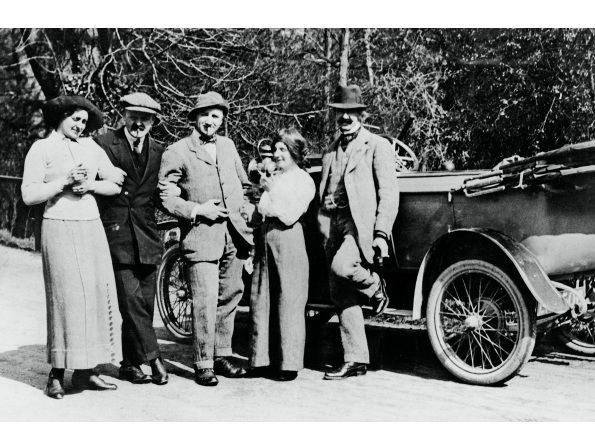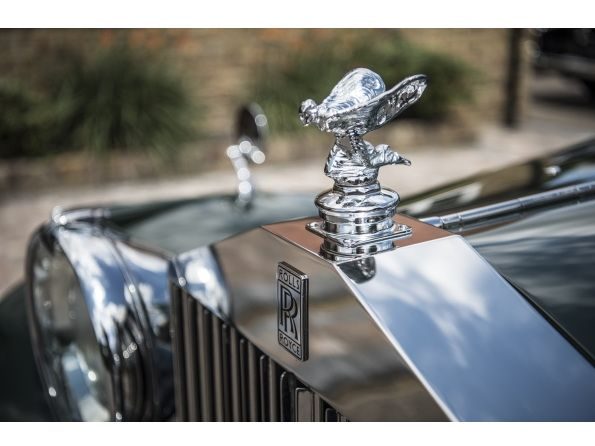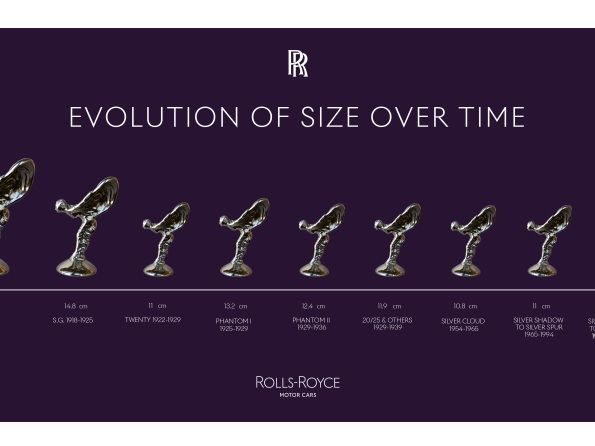Categories more
- Adventures (17)
- Arts / Collectables (15)
- Automotive (37)
- Aviation (11)
- Bath, Body, & Health (77)
- Children (6)
- Cigars / Spirits (32)
- Cuisine (16)
- Design/Architecture (22)
- Electronics (13)
- Entertainment (4)
- Event Planning (5)
- Fashion (46)
- Finance (9)
- Gifts / Misc (6)
- Home Decor (45)
- Jewelry (41)
- Pets (3)
- Philanthropy (1)
- Real Estate (16)
- Services (23)
- Sports / Golf (14)
- Vacation / Travel (60)
- Watches / Pens (15)
- Wines / Vines (24)
- Yachting / Boating (17)
Published
02/23/2022 by Rolls-Royce Motor Cars- Rolls-Royce reveals complex human story behind iconic Spirit of Ecstasy mascot
- Mystery and speculation still surround aspects of its origins
- Figurine has undergone many design changes throughout her long life
- Current manufacturing process means every figurine is unique
“Our Spirit of Ecstasy mascot is the most recognisable automotive emblem in the world. Like our company and our motor cars, she has changed constantly over time, yet remains true to her origins and inspiration. As we enter a new era with Spectre, we have taken the opportunity to revisit our treasured icon and her story, which remains endlessly fascinating, eye-opening and intriguing after more than 100 years. It is both a significant chapter in the brand’s memory, and a rich human drama that, though the product of a bygone age, still resonates with us and our clients today.”
Torsten Müller-Ötvös, Chief Executive Officer, Rolls-Royce Motor Cars
For more than a century, Rolls-Royce motor cars have been graced by the Spirit of Ecstasy mascot, one of the most recognisable emblems ever created. Yet, remarkably, given her immense fame and global reach, aspects of her story remain open to speculation, confusion and no little controversy.
As the marque embarks on a new era of electrification, we revisit the legend to separate established fact and documentary evidence from speculation and hearsay. It is a tale of four people from different backgrounds, whose individual personalities and intertwined, sometimes complex relationships were the genesis for the world’s most famous and desirable icon.
The principal characters in this singular drama are:
- John Walter Edward Douglas-Scott-Montagu, 2nd Baron Montagu of Beaulieu (1866-1929). A prominent motoring pioneer and publisher of The Car Illustrated His ancestral seat in the New Forest is now home to the National Motor Museum.
- Claude Goodman Johnson (1864-1926). Secretary to the Automobile Club of Great Britain & Ireland (later the Royal Automobile Club) before joining The Hon Charles Stewart Rolls in business in 1903. A gifted publicist, his commercial acumen made him the self-styled 'hyphen in Rolls-Royce’.
- Eleanor Velasco Thornton (1880-1915). She is the pivotal figure in the Spirit of Ecstasy story. Originally an actress and dancer, she was also Claude Johnson’s assistant until 1902 when she became Office Manager to Lord Montagu; she was also model and muse to Charles Sykes.
- Charles Robinson Sykes (1875-1950). He was an illustrator and sculptor who worked for both Lord Montagu and Claude Johnson. Under the pseudonym 'Rilette', he designed advertisements and magazine covers, now considered works of art in their own right.
WHAT A TANGLED WEB WE WEAVE…
The Spirit of Ecstasy story is a very human drama, in which fact and fiction often become blurred. What is undoubtedly true is that in 1902, freelance journalist and motoring enthusiast John Montagu – richly titled but perennially short of cash – set up Britain's first motoring magazine, The Car Illustrated, and hired Charles Sykes as his chief illustrator. It is also certain that around the same time, Montagu’s friend, Claude Johnson, employed a young woman named Eleanor Thornton as his assistant at The Automobile Club, where he was General Secretary.
When Montagu met Eleanor, who was both highly intelligent and famed for her beauty, he was instantly smitten and offered her the job of Office Manager at his magazine. She accepted, and the aristocratic publisher and his new colleague – 14 years his junior and from humble origins in south London – soon embarked on a 13-year affair that was as passionate and sincere as it was inevitable and clandestine.
During 1903, Eleanor became pregnant. She and Montagu decided it would be best for the baby to be adopted at birth. For a few seconds, Eleanor held the infant Joan before handing her to Montagu, instructing him “never again to mention the name of the baby”. Eleanor never saw her again; but her father did. He arranged (and paid) for Joan to be initially brought up by an ex‑sergeant from his regiment and his wife, and latterly a doctor and his wife. Over the years that followed he visited his daughter, who knew him only as Uncle John, and did what he could to support her, within the bounds of propriety and secrecy.
THE MUSE FOR AN ICON?
It is here that the various strands of the story start to draw together. Sykes and Eleanor would, of course, have met through their work at The Car Illustrated; but intriguingly, they knew one another already. A few years earlier, Eleanor had taken rooms at The Pheasantry, an artists’ colony in the Kings Road, Chelsea. Here, she lived a secret double life: demure, respectable, professional assistant to Johnson at The Automobile Club by day; sensuous exotic dancer and life-model by night. One of the artists for whom she regularly posed was Charles Sykes.
Although Sykes was employed by Montagu as an illustrator, he was also a talented sculptor, having studied under the eminent Professor Edouard Lanteri at the Royal College of Art. In 1903, he sculpted a trophy, modelled on Eleanor, for Montagu to present at the Gordon Bennett race. Another of Sykes’ works, entitled Bacchante, was shown at the Royal Academy and the Paris Salon. Her face and figure are also strikingly similar to those of his long-time muse.
During this period (the precise date is unknown) Sykes produced a mascot for Montagu's Rolls‑Royce Silver Ghost. Called ‘The Whisper’, it was a small aluminium statuette of a young woman in fluttering robes with a forefinger to her lips. It has been confirmed that Eleanor was the model: whether the mascot was a token of appreciation from Sykes to his friend and employer, or made at Eleanor’s instigation as a gift for her lover, remains a mystery. Whatever the truth, Montagu displayed it on every Rolls-Royce car he owned until his death in 1929; perhaps as a discreet acknowledgment of his love for Eleanor, which he kept secret for so long.
The conventional wisdom is that ‘The Whisper’ was the inspiration for the Spirit of Ecstasy; and that the mascot, therefore, is modelled on Eleanor Thornton. It is an appealing and logical notion, and there are enough similarities to support it. But once again, the story is not as clear-cut as it first appears.
THE ROLLS-ROYCE CONNECTION
In 1910, Eleanor’s erstwhile employer, Claude Johnson, re-enters the narrative. No longer at The Automobile Club, he was now Managing Director of Rolls-Royce, the company co-founded by his former business partner, The Hon Charles Stewart Rolls, and the brilliant engineer Henry Royce.
Royce was already becoming irritated by what he felt were tasteless mascots adorning radiator caps atop Rolls-Royce motor cars, including black cats, devils and a jovial policeman. Claude Johnson, however, spotted an opening, and argued that they should produce their own mascot that would enhance a Rolls-Royce rather than demean it. Eventually, Royce grudgingly agreed; and through his friend Montagu, Johnson commissioned Charles Sykes to create it.
Johnson already had a mental picture of the kind of adornment he wanted. On a trip to Paris, he had been impressed by the artistry of the Grecian marble statue of ‘Nike of Samothrace’, Goddess of Victory, sculpted in 190BC and exhibited in the Palais du Louvre since 1883. Standing nine feet (2.75m) tall, she is depicted as a winged deity descending from the heavens, draped in a flowing tunic and mantle. Sadly, the vicissitudes of time and fortune have deprived her of both arms and her head.
“I want something beautiful, like Nike,” Johnson said to Sykes. “Go and have a look at it.” Sykes did so, but quickly decided Nike was too martial and domineering to be a suitable Rolls-Royce mascot. Having often travelled in Montagu’s Silver Ghosts, he believed a more delicate, ethereal figure would better express the marque's grace, silence and subtle power. Once again, his muse was almost certainly Eleanor Thornton.
But even here, doubt remains. While it seems highly probable that Eleanor was the model for the Spirit of Ecstasy’s overall form, the face could be that of another as it is an excellent likeness of a woman with whom Sykes had a close and adoring relationship – his mother, Hannah Robinson Sykes. Some have speculated that Sykes used his imagination to create a female physique that satisfied his artistic eye and vision of the ideal of womanhood.
WHAT’S IN THE NAME?
Sykes’ new mascot was initially called 'The Spirit of Speed'. The title that would make her immortal appears in a letter from Rolls-Royce to John Montagu. In it, the Company describes its search for a mascot that would convey “the spirit of the Rolls-Royce – namely, speed with silence, absence of vibration, the mysterious harnessing of great energy, a beautiful living organism of superb grace like a sailing yacht”.
The letter adds that when Sykes designed his “graceful little goddess”, he had in mind “the Spirit of Ecstasy, who has selected road travel as her supreme delight and alighted on the prow of a Rolls-Royce car to revel in the freshness of the air, and the musical sound of her fluttering draperies”.
Rolls-Royce registered the Spirit of Ecstasy as its intellectual property in 1911. However, it is noteworthy that she did not receive the unreserved blessing of either of its founders. Sir Henry Royce disliked mascots of any kind; and The Hon Charles Stewart Rolls never set eyes on her, since she was created after his death in a flying accident in June 1910. It is due almost entirely to the vision, acumen and sheer force of character of Claude Johnson that she exists.
His instincts were proved correct when, in 1920, Rolls-Royce entered the Spirit of Ecstasy in a competition in Paris to find the world’s best motor car mascot. She won, of course, and Sykes received a gold medal.
It is also not often appreciated that the Spirit of Ecstasy was an ‘Optional Extra’ right up until 1939. Perhaps reflecting Sir Henry’s undimmed antipathy, mascots graced only about 40% of the 20,000 or so cars delivered during this period, though many were later retrofitted.
CHANGING WITH THE TIMES
The Spirit of Ecstasy has been a defining feature of the Rolls-Royce brand since 1911. But just as the marque and its motor cars have constantly evolved and changed with the times, so she herself has undergone her own periodic transformations.
In her original 1911 form, she was a statuesque 6 7/8 inches (~18cm) in her bare feet; by the 1960s, she had passed through eight iterations and stood a more petite 4 5/16 inches tall (~11cm). The distance from her nose to the tip of her outstretched robes had also shrunk proportionally, from five inches to three. There have also been subtle variations in her base shape, stance and precise inclination of her 'wings' over the decades.
More radically, clients buying models from 1934 until 1959 had the option of a kneeling figure, which some considered better suited to the coachwork designs of the period.
In the 1970s, some countries tried to ban the mascot on safety grounds. In Switzerland, for example, clients weren’t allowed to display her at all, and on receiving their cars found her languishing in the glove compartment. Rolls-Royce’s typically elegant and ingenious solution was to mount the mascot on a spring-loaded base, allowing her to sink into the radiator out of harm’s way at the merest touch. This retraction mechanism has evolved into a smooth, graceful movement known as ‘the rise’ and is a standard feature on every Rolls-Royce motor car hand-built at Goodwood.
REMADE FOR THE MODERN ERA
One of the many remarkable aspects of the Spirit of Ecstasy’s story is that from 1911, every figurine was personally cast, inscribed and hand-finished by Charles Sykes himself. His daughter, Josephine, took over in 1928 and continued until manufacture was interrupted by the outbreak of war in 1939. Each Spirit of Ecstasy from this period is therefore minutely different from every other.
Today, they are made by specialists in Southampton, England, using a wax casting process combining methods and materials dating back over 5,000 years with 21st Century technology.
Each figurine is based on a three-dimensional computer-generated image, digitally mapped from the original Spirit of Ecstasy. Using this image, skilled craftspeople created a solid cast tool, made by hand using cutters measuring just 0.2mm in size to ensure even the finest details were precisely replicated. From this cast tool, they produced a highly accurate wax model of the figurine, which was then coated in ceramic. After this coating had dried, the wax was melted away, leaving a perfect mould from which the new cast would be taken.
Each figurine is made by filling the mould with molten stainless steel, at a temperature of 1600°C. Once the steel has cooled, the mould is opened to reveal the Spirit of Ecstasy in all her glory. The final transformation takes place in the Finishing Department, using a process called peening. The casting is blasted by millions of stainless-steel balls, just 17 thousandths of an inch (0.04mm) in diameter, which help to polish the surface without being abrasive. After machining, a final mirror polish and stringent quality assurance checks, the completed figurine takes her rightful place above the iconic Rolls-Royce grille.
In 2020, Rolls-Royce unveiled The Spirit of Ecstasy Expression. For this wholly new visual treatment, designers redrew her in a simplified, modern form to be used as a graphic symbol as part of the marque's updated corporate identity. The computer-generated, online-friendly illustration translates the figurine's curves into a ribbon of parallel lines that undulates and changes according to its setting. It is designed to evoke movement; a silky, fluid form that appears to drape and flow over physical and digital surfaces.
Today, Rolls-Royce Motor Cars announced that the Spirit of Ecstasy would take a new form for her adornment on Spectre, the marque’s first electric motor car. She is more streamlined and graceful than ever before – the perfect emblem for the most aerodynamic Rolls-Royce ever created, and for gracing the prow of our bold electric future.
The earliest Spectre prototypes have a drag coefficient (cd) of just 0.26, making it the most aerodynamic Rolls-Royce ever created. The figure is expected to improve during the product’s exhaustive testing protocols undertaken in 2022.
THE END OF THE AFFAIR
On 30 December 1915, Montagu and Eleanor Thornton were enjoying lunch in the first-class saloon of the P&O passenger ship SS Persia. They were sailing through the Mediterranean en route to India, where Montagu had been made Chief of Mechanical Transport for the British army. Eleanor was to disembark at Port Said and return to England for the duration.
The ship was struck by a torpedo and sank in less than five minutes. Eleanor Thornton, together with hundreds of other passengers, was never seen again.
Montagu, however, was lucky. After 38 hours adrift in a lifeboat, suffering with a broken shoulder and a damaged lung, he and a handful of other survivors were picked up by a passing liner. While recovering in Malta as a guest of the Governor, he enjoyed the bittersweet pleasure of reading his own obituaries in the London newspapers.
Montagu never got over the loss of Eleanor, which of course he could never mention publicly. But for the rest of his life, she was with him in spirit wherever he travelled in his Rolls-Royce motor car.

















